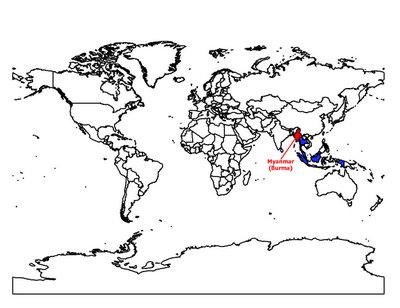“Of all fruit the best is the mango, of all meat it’s pork, and of all leaves it’s tea.”
A popular Burmese expression that sums up their favourite traditional foods.
Well we are finally leaving Thailand, and this week we're heading over the northern border to Myanmar (formerly Burma) via the aptly named restaurant: Burmese House.

The three countries that border Myanmar - India, China, and Thailand - have influenced much of Burmese cuisine. Indian influences are found in Burmese versions of Indian dishes such as samosas and biryani, as well as the heavy usage of curries and spices. Ethnic Indians have a monopoly on such dishes. Chinese influence in Burmese cuisine is shown in the use of ingredients like bean curd and soya sauce, as well as in stir-frying techniques.
Traditionally, the Burmese eat their meals with dishes on low tables, while sitting on bamboo mats, and dishes are served more or less at the same time. Out of respect, the eldest diners are always served first before the rest join in; even when the elders are absent, the first morsel of rice from the pot is scooped and put aside as an act of respect to one's parents, a custom known as oo cha (lit. first serve). Burmese people eat with their right hand, forming the rice into a small ball with only the fingertips and mixing this with various morsels before popping it into their mouths. Chopsticks and a Chinese style spoon are used for noodle dishes, although noodle salads are more likely to be eaten with just a spoon. Knives and forks are used rarely in homes but will always be provided for guests and are available in restaurants and hotels. Drinks are not often served with the meal and, instead, the usual liquid accompaniment is in the form of a light broth or consomme served from a communal bowl. However, the Burmese beverage of choice is light green tea.
Different regions of Myanmar have different variations of “standard” dishes. Use of seafood is more prevalent along coastal cities such as Mawlamyine (formerly Moulmein), while meat and poultry are more commonly used in landlocked cities. Fish and shrimp from rivers, lakes and streams, however, have traditionally been the main source of protein in a variety of ways, fresh, salted whole or filleted,salted and dried, made into a salty paste, or fermented sour and pressed. Beef and pork, although certainly not forbidden, are avoided by many Buddhists and Muslims. Vegetarian dishes are also common, as especially during the Buddhist lent (Wa-dwin), a three-month rains retreat, eating only before midday (u bouk saunk) and abstaining from meat (thet that lut) is observed by many devout Buddhists.
Ingredients used in Burmese dishes are often fresh. Many fruits are used in conjunction with vegetables in many dishes. Below is a selection of some of Myanmar’s more notable dishes
Mohinga – the unofficial national dish of rice vermicelli in fish broth
Htamin thouk – rice salad with tomato puree, potato,glass noodle, toasted chickpea flour, crushed toasted dried fermented beancake,crushed dried shrimp, crushed dried chilli, garlic and dressed with cooked peanut oil, fish sauce, lime or tamarind and coriander
Kat kyi hnyat (lit. 'cut with scissors') – a southern coastal dish (from the Dawei area) of rice noodles with a variety of seafood, land meats, raw bean sprouts, beans and fried eggs comparable to pad thai
Kya zan hinga – glass noodle soup with wood-ear mushrooms,egg, dry flower, onion
Shauk thee thouk – sliced lemon (no pith or rind), toasted chickpea flour, crushed roasted peanut, crushed dried shrimp, crushed dried chilli, baked fish paste, cooked oil with onions (goes very well and often served with kya zan hinga)
Oun no hkauk swè – curried chicken and wheat noodles in a coconut milk broth similar to Malaysian laksa and Chiang Mai's khao soi
For more dishes, including Chinese-, Indian- and Shan-inspired dishes, please go to http://en.wikipedia.org/wiki/Cuisine_of_Myanmar
No comments:
Post a Comment